What to Wear Hiking in Winter: Cold Weather Layering Basics
These are my go to women’s winter hiking clothes and how I layer everything to stay warm on snowy hikes.
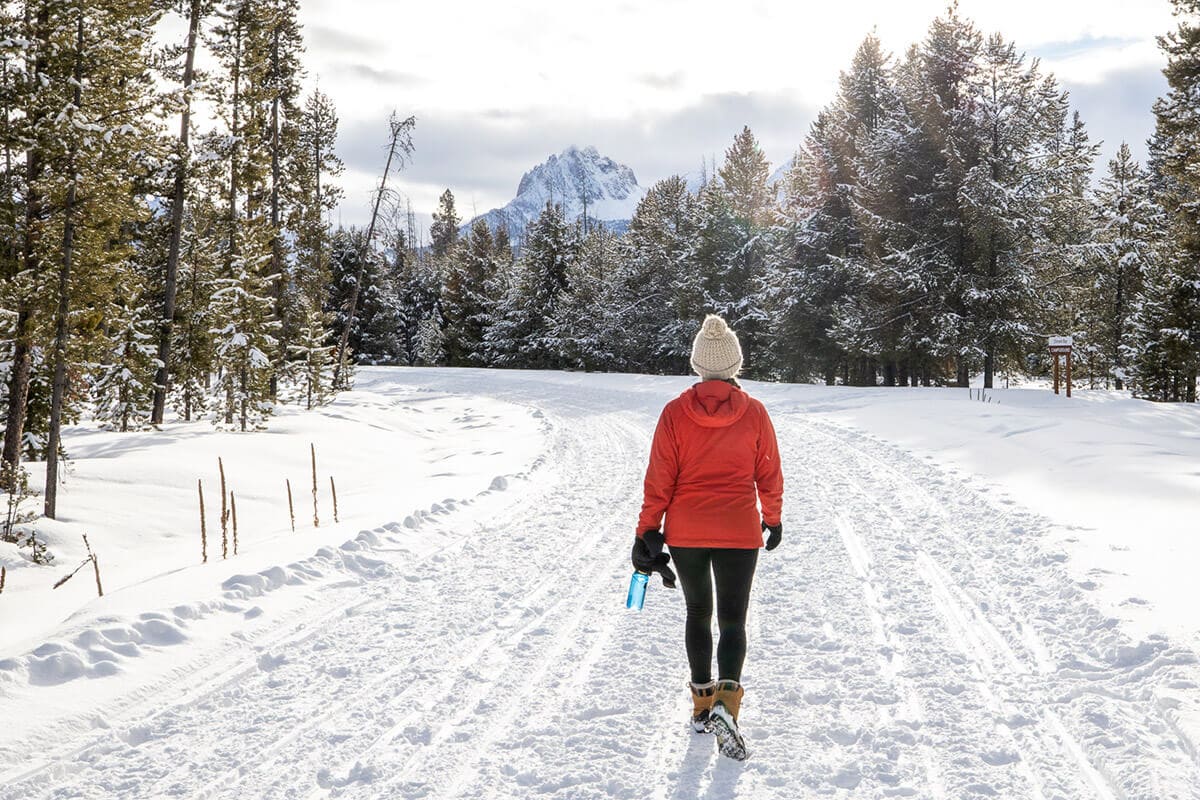
When I first moved to Salt Lake City 10 years ago, I didn’t know what to wear hiking in winter. The first few times I went out for a snowy hike, I wore my ski clothes and ended up a hot sweaty mess.
Over time, I refined my layering system, and now after a decade of hiking in the Utah winters, I have my winter hiking clothes dialed.
In this post, I share my favorite winter hiking clothes and tips for layering, so you can be warm (but not too hot) and prepared if the weather suddenly takes a turn for the worst.
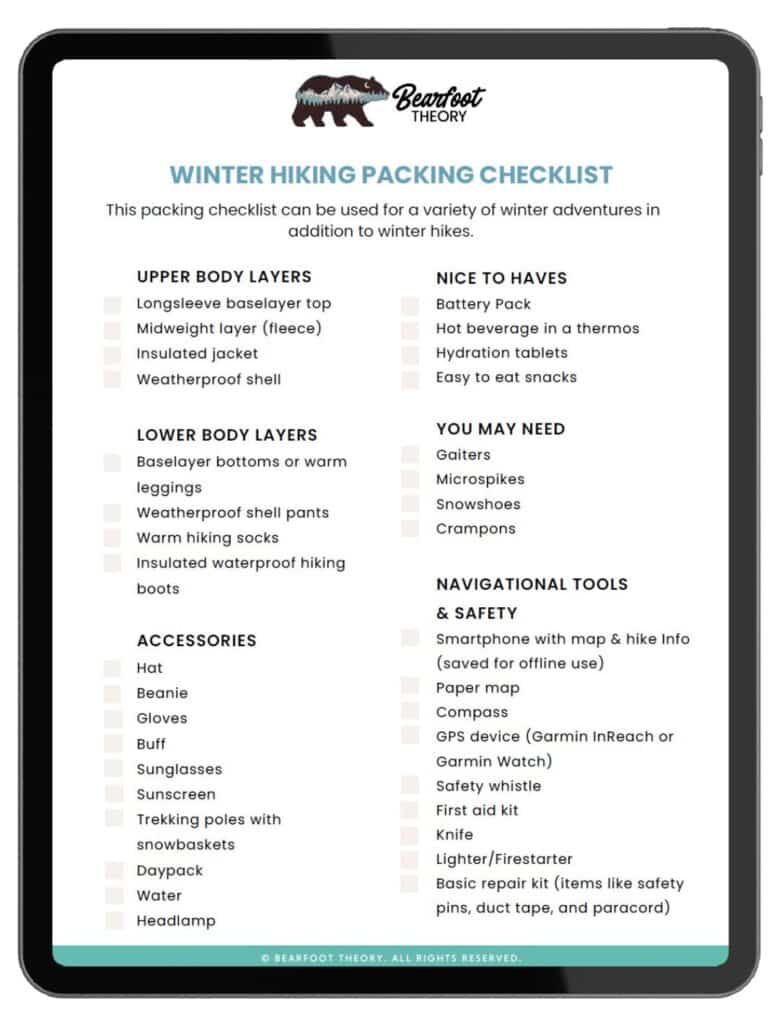
Get my Winter Hiking Packing Checklist
when you enter your email below
This post may contain affiliate links.
Save this post!
Enter your email & I'll send this post to your inbox! You'll also receive my weekly newsletter full of helpful advice for planning your adventures.
The Importance of Layering for Winter Hiking
The key to dressing for winter hiking is to wear layers that will keep you both warm AND dry – that means from the elements as well as your sweat. Depending on the difficulty of the trail and weather conditions, you may find yourself needing to take off and put on layers throughout the hike in order to stay comfortable.
For example, on the uphill sections, I usually start to sweat. When this happens, I immediately stop and shed a layer before I get too clammy. This is important because sweat can make you feel wet and cold when it’s time to go downhill.
Once I reach the high point of my winter hike and start going downhill, I typically put my layers back on. You don’t produce as much body heat on the downhill, and you need those extra layers of clothing to stay warm.
The exact layers you should wear on your winter hike depends on the temperature and conditions. However, you should always be prepared for the worst by having extra layers in your backpack. I will go through every single layer I wear next.
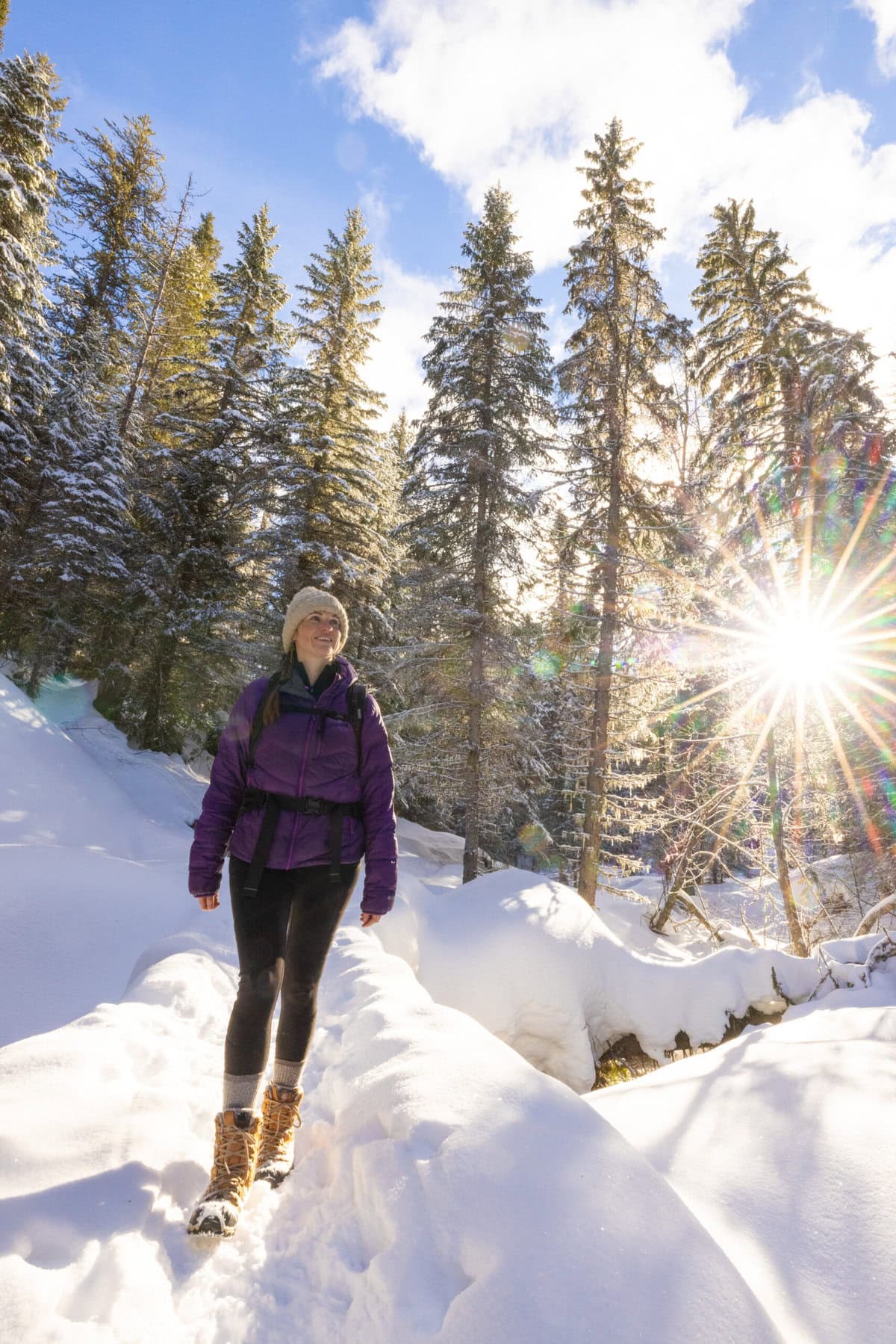
Upper Body Layers
For my upper body, these are the layers I always pack on my winter hikes.
I will always bring these layers, but the combination of ones I actually wear will vary throughout my hike. For example, I may start with a base layer, a mid-layer and my insulating jacket and take off my mid-layer when I get warm. Or if it starts to rain or snow, I’ll add my waterproof shell. It just depends on the conditions and my body temperature.
Ideally, you want to choose layers that are light and packable so you can stuff them in your backpack if you decide to take one off.
Once you have a few winter hikes under your belt, you’ll see how much heat your body generates, and then you can adjust your cold-weather hiking clothes accordingly.
Base Layer / Shirt
Your next-to-skin winter hiking base layer is all about regulating your body temperature while also wicking sweat. You sweat when you’re active, and in winter months it’s extra important that your winter hiking clothes help move the sweat away from your skin so you stay dry, rather than damp and cold.
Base layers should be made of synthetic fabric or merino wool that wick moisture and dry quickly. Avoid anything cotton (cotton t-shirts, cotton sweatshirts) because cotton stays damp and heavy and loses its insulating properties when wet. This also applies to your sports bra.
The thickness of your next-to-skin base layer depends on how cold it is outside and is also based on personal preference. Some people prefer to wear a lightweight synthetic hiking t-shirt underneath a mid-weight base layer. Others are fine with a single lightweight base layer. You may have to experiment a bit until you find the system that works best for you.
Here are my go-to base layers for winter hiking:
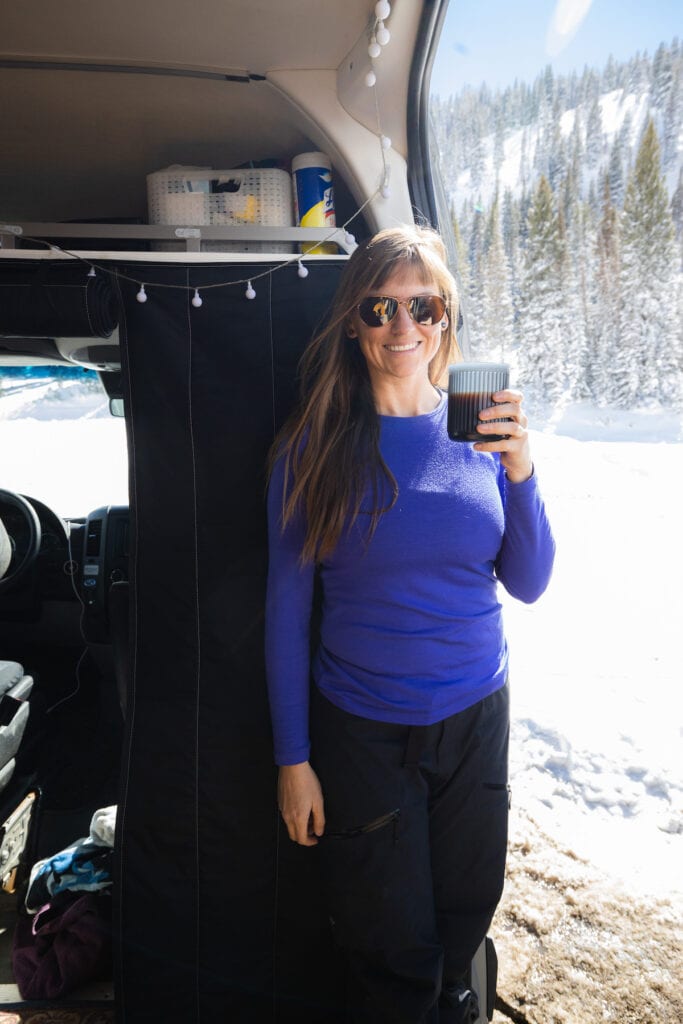
Mid-Layer Top
On top of my base layer, I’ll wear a mid-layer, such as a fleece or another mid-weight base layer. I usually choose a mid-layer that covers my neck . Here are my favorite options:

Insulated Jacket
Having an insulated jacket is critical for maintaining body heat by trapping air close to your body. Generally, a warm insulating layer will be made of down or synthetic down.
Keep in mind that down isn’t warm if it gets wet, so if you live in a wet climate, a synthetic jacket will be more versatile.
These are my favorite winter hiking jackets.

Waterproof Shell
If there is a chance of sleet, snow, rain, or wind, you’ll want to add a weatherproof hardshell over your winter hiking clothes. This will protect you from the elements and keep your other layers dry.
You’ll want an outer layer that is waterproof but still breathable, as well as packable so you can stuff it in your backpack when you aren’t wearing it. A rain jacket or a backcountry ski shell are both good choices. I’d avoid wearing a super heavy insulated ski jacket which will cause you to overheat. Plus, a ski jacket is bulky so if you end up wanting to take it off, you’ll have a hard time cramming it in your pack.
I prefer weatherproof shells that have armpit vents that zip open when you get hot in order to provide better airflow. You’ll also want to take into account the layers you might be wearing underneath when figuring out what size shell you need.
Here are my go-tos:
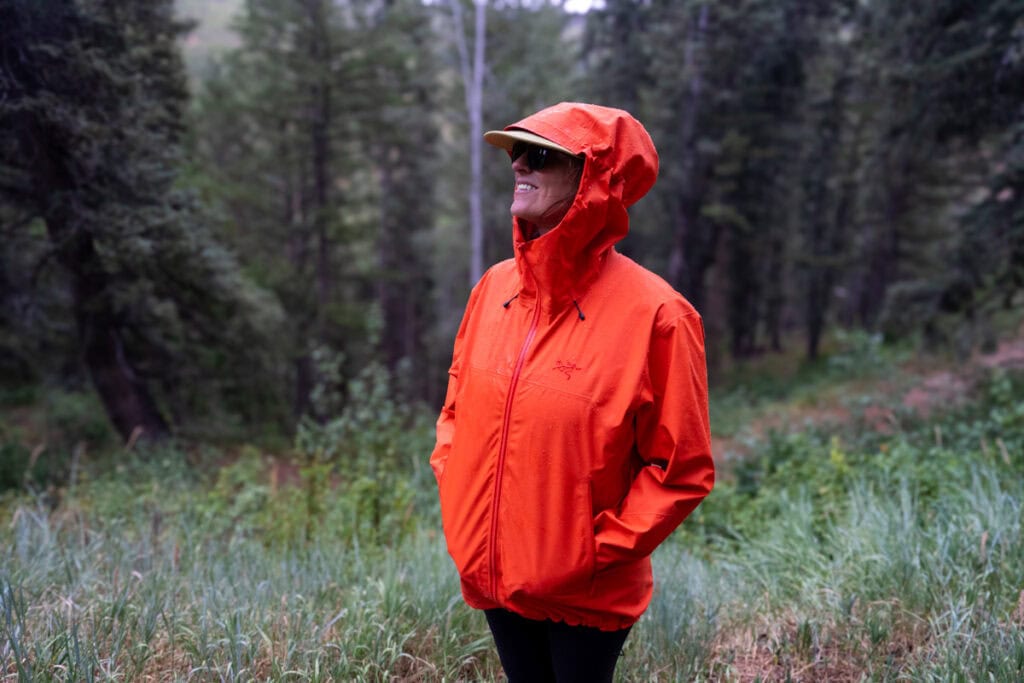
Read next: Explore more waterproof shells here in my guide to the Best Women’s Rain Jackets.
Lower Body Layers
Here is what my layering system looks like for my legs that I’ll adjust based on conditions:
Base layer Bottoms
Just like on your upper body, the next-to-skin base layer on your lower body should help keep you warm while wicking sweat. As with all of your winter hiking clothes, you’ll want to stick to synthetic fabric or merino wool and avoid cotton.
Here are my favorite long johns for winter hiking:
Hiking Pants
For hiking pants, I waver between normal hiking pants paired with the long johns mentioned above OR a pair of fleece-lined winter hiking pants where I can skip the extra layer underneath. Here are my favorite hiking pants specifically designed for winter.
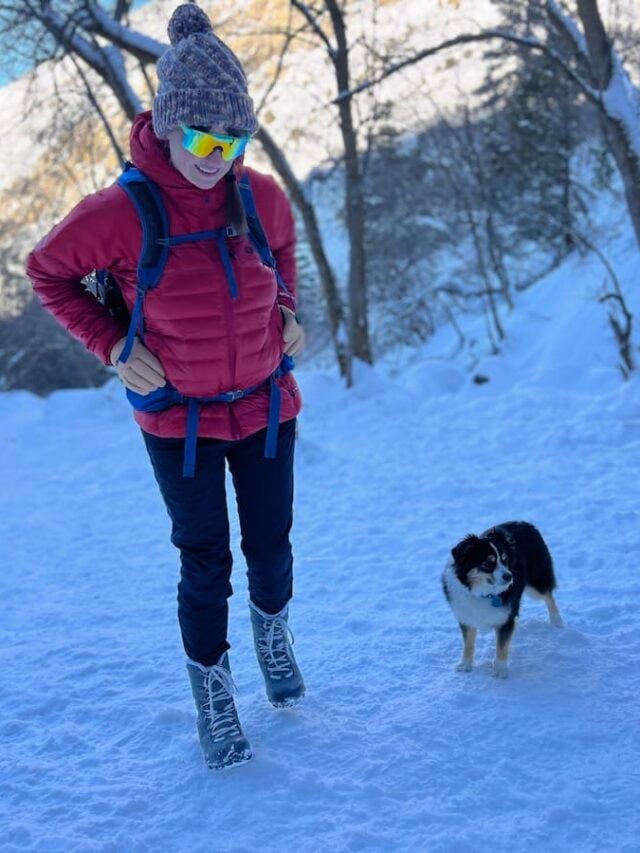
Weatherproof Shell Pants
If it’s sunny and there’s no chance of rain or snow, I’ll skip the weatherproof pants, especially if I’m wearing one of the water-resistant winter hiking pants I just mentioned.
However, if it’s raining or snowing, I will add a pair of rain pants or even snow pants to make sure my legs stay dry.
Here are some good choices:
Winter Accessories
You lose most of your body heat through your head and extremities, so having the right accessories is important for keeping you warm on your winter hikes. I always have these with me:
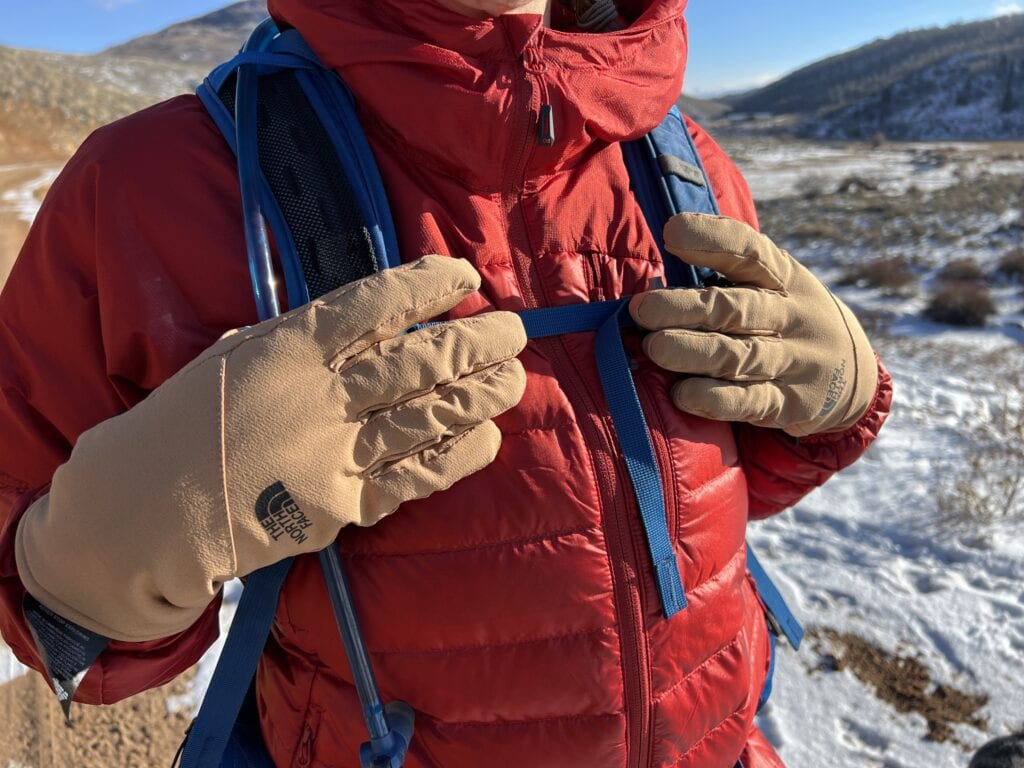
Winter Hiking Footwear
My toes get really cold when I’m hiking in snow, so I always wear insulated boots and wool socks. I also will wear microspikes if the trail is icy.
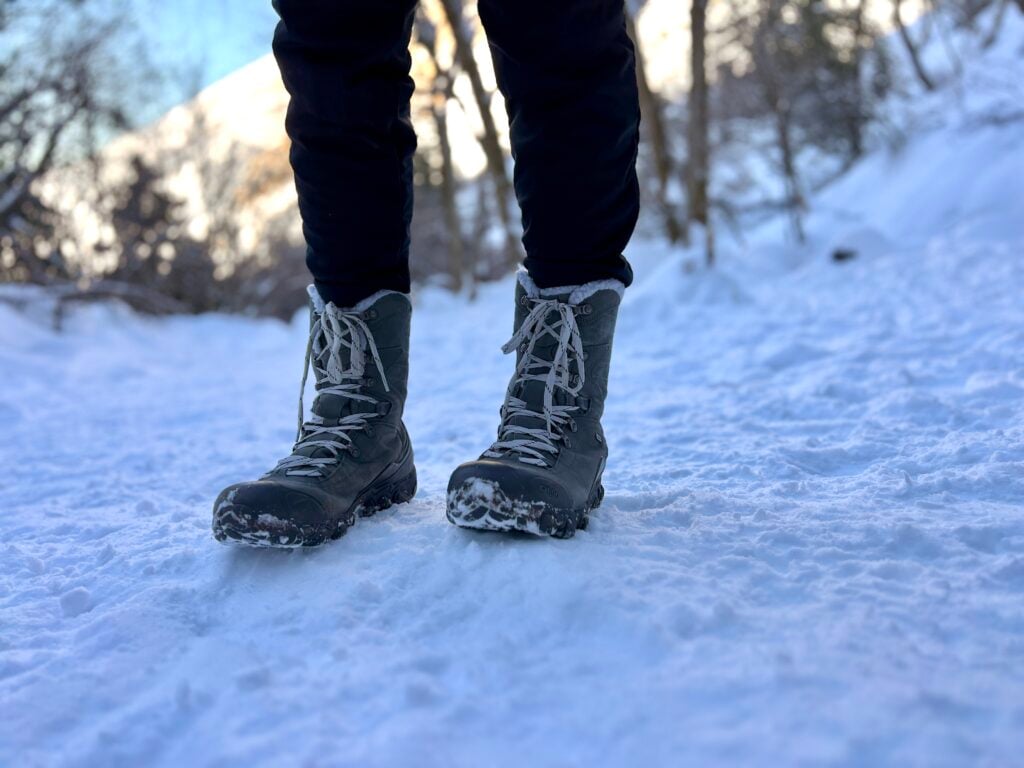
Save this post to Pinterest
More Winter Tips
I hope these tips and recommendations for winter hiking clothes help you plan and prepare for an awesome cold-weather hiking adventure! Got questions? Leave them below in the comments.

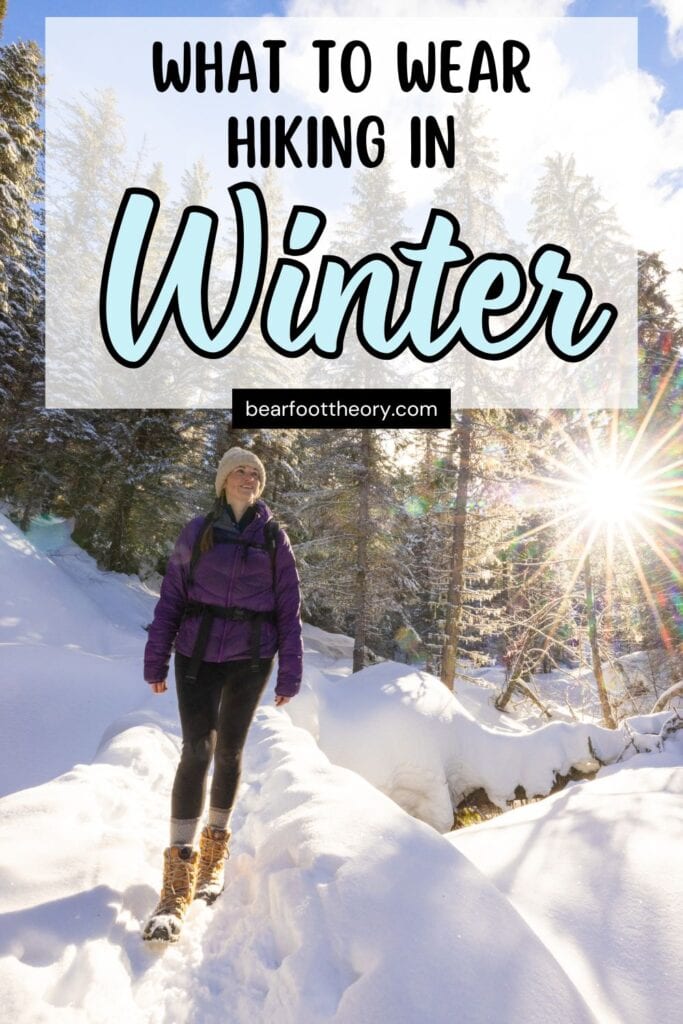
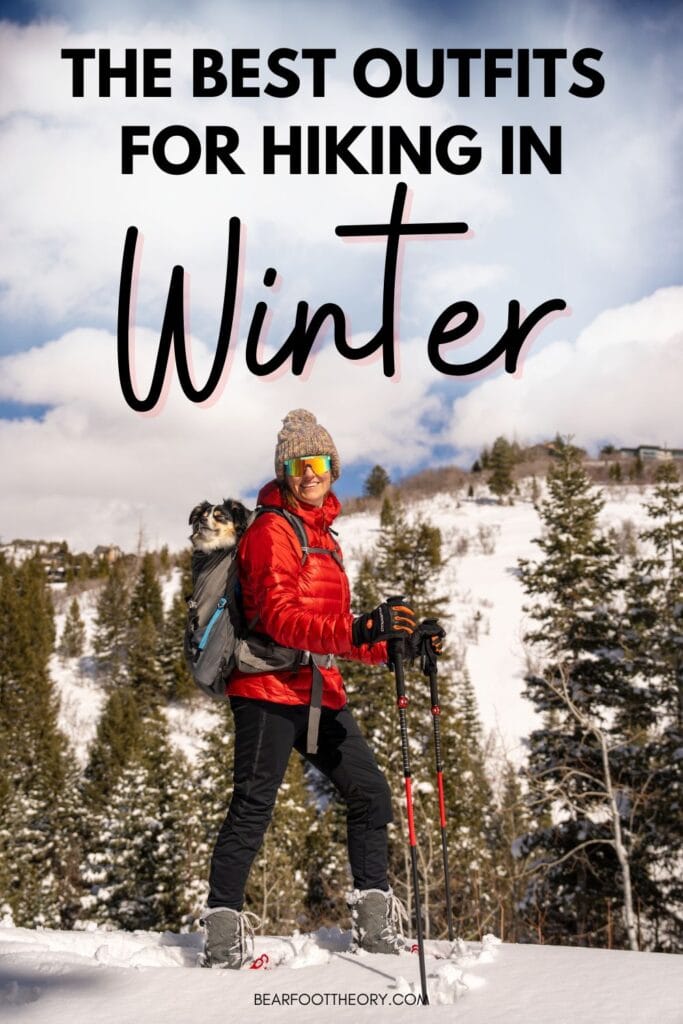
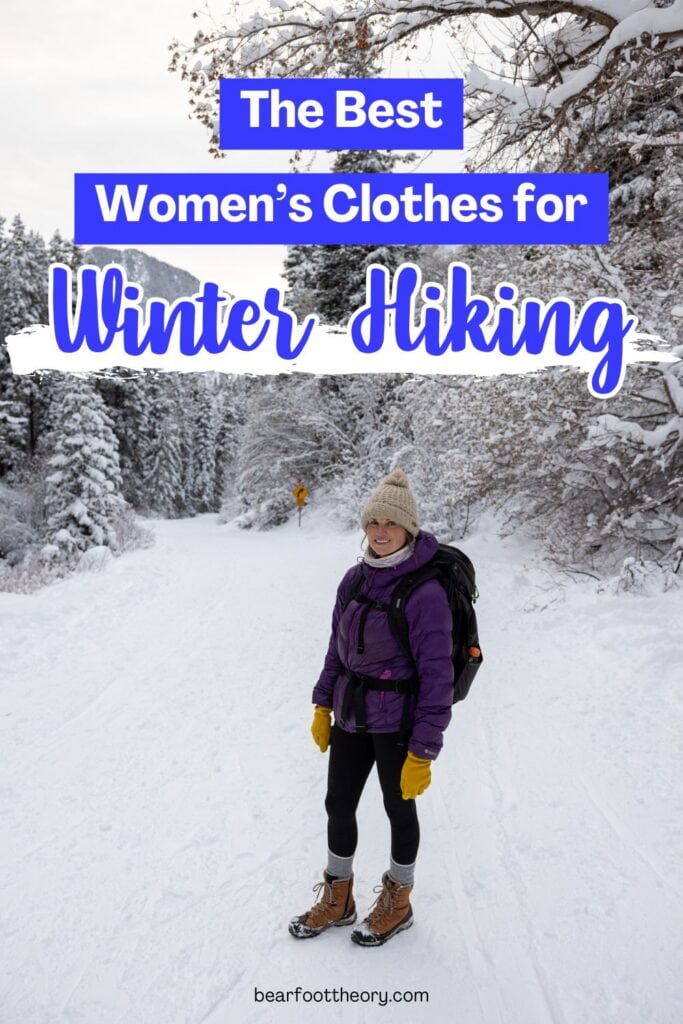
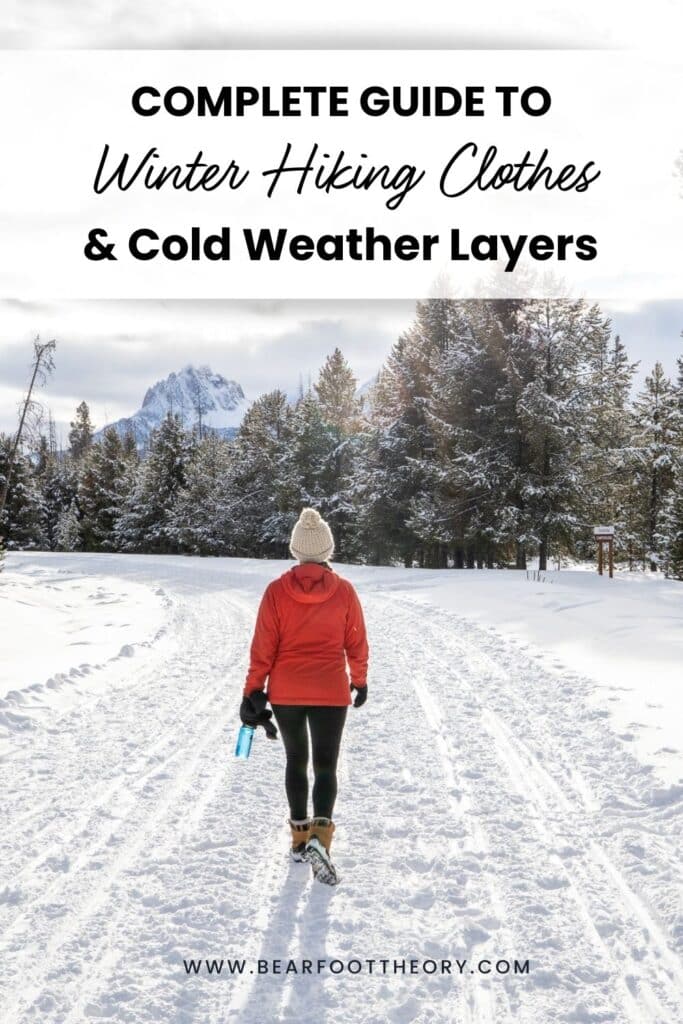


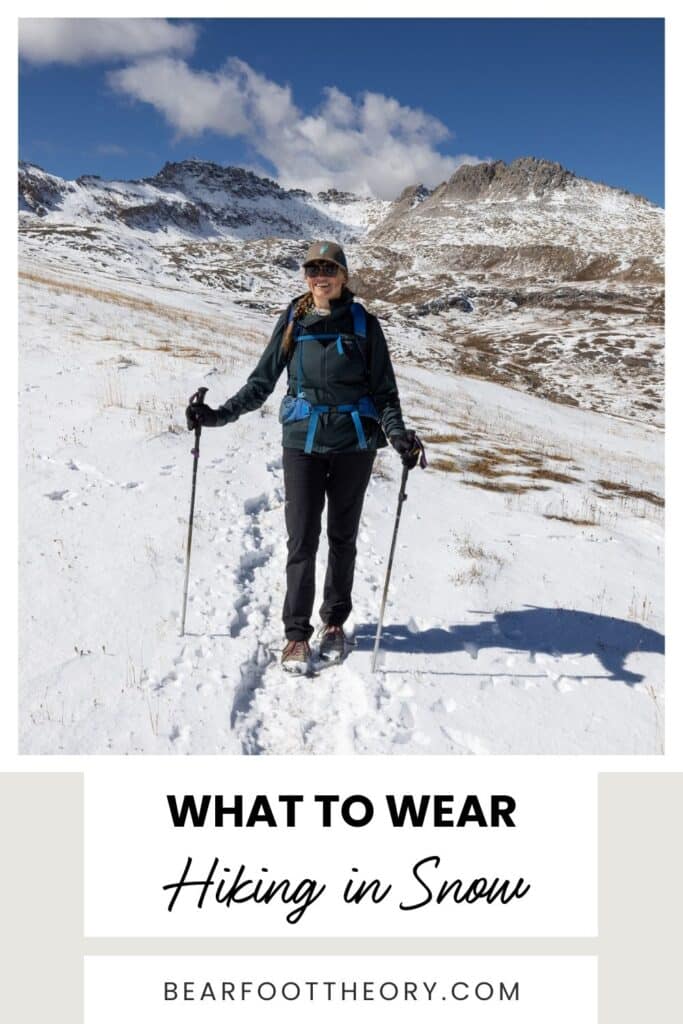

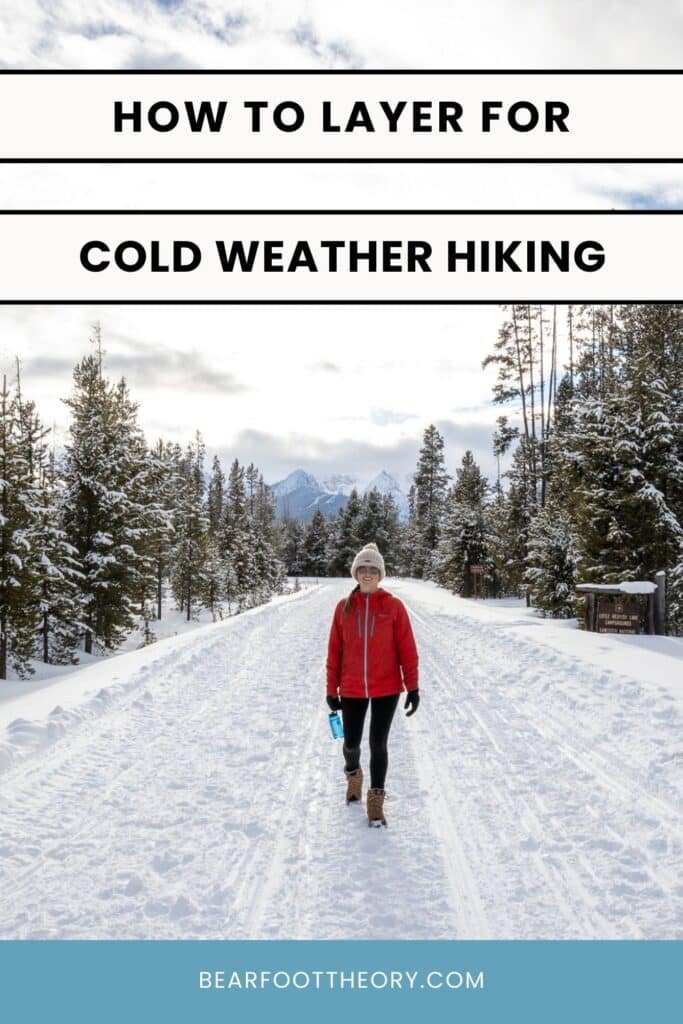
Awesome list! We have been looking for suggestions for what to buy for our winter hikes – thanks for sharing these!
I would suggest that you take a look at a brand new base layer fabric “CARFIBEX” being crowdfunded at the moment by Iron Ocean, it looks like it could potentially set the standard for all base layers to come.
Paul
Amazing post. I think this is the right choice for me. Thanks for sharing this post.
Yes. These are the list that I have in mind right now.
Great article! There is a best collection of clothes which will help to enjoy cold weather hiking. I like this article so much. Thanks and keep sharing.
We are all very happy to be able to cover your story.
Hi! Do you have recommendations for kids items, especially babies and toddlers?
Hi Christie! We don’t at the moment but it’s something we’ll keep in mind for future content. Thanks for reading 🙂
Backcountry Exposure on YouTube just did a great video on this. You can buy REI used gear or borrow from friends to test out pieces and resell them when you’re done to save $. Patagonia makes great mid layers & shells as well as Smartwool for base layers. Hope that helps albeit a year late since I just saw this article.
Hi Karen, thanks for the tips! Borrowing from a friend or buying secondhand is a great way to test gear and see what works best for you before investing.
Fabulous winter hiking clothes that look good all year round are here. We use these coats at work to stay warm outside.
Do you have any gear recommendations for hiking East GNP for early Sept?
Early September is shoulder season, so our fall hiking clothes guide will have great gear recommendations: https://bearfoottheory.com/what-to-wear-hiking-in-fall/
Enjoy your trip!
Such a great suggestions. i was worried about what to wear for a hike in winter. I am planning to go for a hike in winter. This article is very helpful for the people who are looking for hike in winter. The content has valuable information about the clothes to wear for a hike in winter. Thank you for this great content.
Thanks for reading!
Thank you for this informative article on winter hiking clothes and layering. As someone who enjoys outdoor activities, I greatly appreciate the tips and guidance you provided.
You highlight an important aspect of winter hiking, which is finding the right balance when it comes to layering. It’s crucial to avoid both overheating and being underdressed, as they can lead to discomfort and even safety hazards like hypothermia. Your emphasis on being prepared for wet and chilly weather is especially valuable, as winter conditions can be unpredictable.
I also appreciate your sponsorship disclosure and recommendation of REI Co-op. It’s great to know that they offer a 1-year return policy and Member-only coupons, which can be helpful when purchasing outdoor gear.
The advice you shared about adjusting layers during the hike, especially during uphill sections, makes a lot of sense. Managing sweat and preventing it from making you feel cold is important for maintaining comfort and avoiding potential health risks. I wonder if you have any specific tips for choosing the right materials or fabrics for winter hiking clothes? Are there certain types of materials that are particularly effective in keeping both warmth and moisture at bay?
Overall, this article has provided me with a better understanding of the essentials for winter hiking and layering techniques. It’s evident that you have a deep knowledge of the topic, and I’m grateful for the valuable insights you’ve shared. I look forward to applying this information to enhance my winter hiking experiences.
Thank you for sharing your expertise and contributing to the outdoor community through your blog. Keep up the great work!
Thanks for reading & glad you found it helpful!
Thanks!!